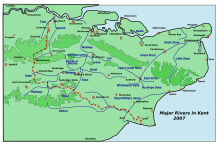| River Cray | |
|---|---|
 Confluence of the River Darent and the River Cray (right) on Crayford Marshes. | |
 | |
| Physical characteristics | |
| Source | |
| • location | Orpington Pond TQ 467 668 |
| • coordinates | 51°22′51″N 0°06′24″E / 51.3809°N 0.1067°E |
| • elevation | 54 m (177 ft) |
| Mouth | |
• location | River Darent TQ 536 760 |
• coordinates | 51°27′43″N 0°12′38″E / 51.4619°N 0.2105°E |
• elevation | 2 m (6 ft 7 in) |
| Length | 9 miles (14 km) |


The River Cray is the largest tributary of the River Darent. It is the prime river of outer, south-east Greater London, rising in Priory Gardens, Orpington, where rainwater percolates through the chalk bedrock of the Downs to form a pond where the eroded ground elevation gives way to impermeable clay. Initially it flows true to form northwards, past industrial and residential St Mary Cray, through St Paul's Cray (where it once powered a paper mill) and through Foots Cray, where it enters the parkland Foots Cray Meadows, flowing under by Five Arches bridge (built in 1781 as part of their designs by Capability Brown). It then flows by restored Loring Hall (c.1760), home of the Lord Castlereagh who killed himself there in 1822. It continues through North Cray and Bexley. It neighbours a restored Gothic (architecture) cold plunge bath house, built around 1766 as part of Vale Mascal Estate. It is then joined by the River Shuttle (a small brook) and then continues through the parkland of Hall Place, which was built for John Champneys in 1540. The Cray turns eastward through Crayford and Barnes Cray to join the Darent in Dartford Creek. The Creek is a well-watered partly tidal inlet (of the Tideway) between Crayford Marshes and Dartford Marshes by a slight projection of land, Crayford Ness. The villages through which the Cray flows are collectively known as "The Crays".